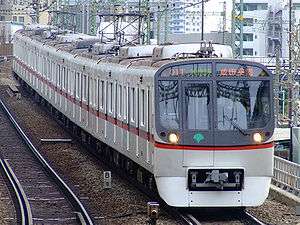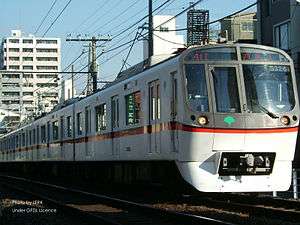Toei Asakusa Line
| Asakusa Line | |||
|---|---|---|---|
|
| |||
|
Toei 5300 series EMU bound for Nishi-Magome Station | |||
| Overview | |||
| Type | Heavy rail | ||
| Locale | Tokyo | ||
| Termini |
Nishi-Magome Oshiage | ||
| Stations | 20 | ||
| Daily ridership | 669,603 (FY2014)[1] | ||
| Operation | |||
| Opened | December 4, 1960 | ||
| Owner | Tokyo Metropolitan Bureau of Transportation (Toei) | ||
| Depot(s) | Magome | ||
| Technical | |||
| Line length | 18.4 km (11.4 mi) | ||
| Track gauge | 1,435 mm (4 ft 8 1⁄2 in) | ||
| Electrification | 1,500 V DC overhead catenary | ||
| Operating speed | 70 km/h (43 mph) | ||
| |||
The Toei Asakusa Line (都営地下鉄浅草線 Toei Chikatetsu Asakusa-sen) is a subway line in Tokyo, Japan, operated by the Tokyo subway operator Toei Subway. The line runs between Nishi-Magome in Ōta and Oshiage in Sumida. The Asakusa Line was the first subway line in Japan to offer through services with a private railway. Today, it has more through services to other lines than any other subway line in Tokyo. Keikyu operates through trains on the Keikyu Main Line to Misakiguchi and the Keikyu Airport Line to Haneda Airport. The Keisei Electric Railway operates through trains on the Keisei Oshiage Line to Inba-Nihon-Idai and the Keisei Main Line to Narita Airport, and the Shibayama Railway runs trains via the Keisei Main Line and the Shibayama Railway Line to Shibayama-Chiyoda.
The Asakusa Line is actually split in two sub-lines, (Narita -) Oshiage - Sengakuji (- Haneda) and Sengakuji - Nishi-Magome, only 25% of the trains make all station stops on the Asakusa Line.
On maps and signboards, the line is shown in "rose" (O). Stations carry the letter "A" followed by a two-digit number.
History
The Toei Asakusa Line was the first subway line constructed by the Tokyo Metropolitan Government. The line number is Line 1, because it was technically the first subway line in Tokyo to be planned in the 1920s as an underground route connecting the Keikyu and Keisei Electric Railway via Shinagawa, eventually allowing for through trains between these two railways. In its original plan form, the line would have actually bypassed Asakusa Station entirely. However, the plan was changed to take advantage of the existing Tōbu Isesaki Line and Tokyo Metro Ginza Line connections at Asakusa.
Construction of this line began on August 27, 1956 after years of delays, and the initial 3.2 km segment between Oshiage and Asakusabashi opened on December 4, 1960. The line then opened in stages from north to south:
- May 1962: Asakusabashi to Higashi-Nihonbashi
- September 1962: Higashi-Nihonbashi to Ningyōchō
- February 1963: Ningyōchō to Higashi-Ginza
- December 1963: Higashi-Ginza to Shinbashi
- October 1964: Shinbashi to Daimon
- June 1968: Daimon to Sengakuji (Through service with Keikyū begins)
- November 15, 1968: Sengakuji to Nishi-Magome
The line was named Asakusa Line on July 1, 1978.
From 1998 to 2002, the Asakusa Line was used as part of a rail connection between Tokyo's two major airports, Haneda and Narita. While a few trains still run between the airports (see below), the service has greatly diminished in frequency since 2002.
In 2005, a research group of government, metropolitan and railway company officials proposed that the Asakusa Line be connected to Tokyo Station via a spur to the north of Takarachō Station. This would provide Tokyo Station's first direct connection to the Toei subway network. It would also make it possible to reach Haneda Airport in 25 minutes (versus 35 minutes today) and Narita Airport in 40 minutes (versus 57 minutes today).[2] This plan has yet to be finalized or formally adopted.
Services
- ■ Local (普通 futsū) trains operate between Nishi-Magome and Sengakuji approximately every ten minutes and are timed to connect to Keikyu through service trains at Sengakuji.
- ■ Rapid service (快速 kaisoku) trains operate between Nishi-Magome and Keisei Sakura Station approximately every twenty minutes. They make all station stops on the Asakusa Line.
- ■ Limited Express (快特 kaitoku) trains operate approximately every minutes. They generally use Keikyu rolling stock and have a southern terminus at Misakiguchi Station or Keikyu Kurihama Station. They operate as Limited Express trains only on the Keikyu line, and provide local service on the Asakusa Line and Keisei Oshiage Line. Their northern terminus is generally either Aoto Station or Keisei Takasago Station.
- ■ Limited Express (快特 kaitoku) trains operate approximately every twenty minutes and make all stops (local service) on the Asakusa Line, providing Limited Express service on the Keikyu line between Sengakuji and Haneda Airport Domestic Terminal. Their northern terminus is usually either Inzai-Makinohara Station or Inba-Nihon-Idai Station on the Hokuso Railway.
- ■ Airport Limited Express (エアポート快特 eapōto kaitoku) trains operate approximately every twenty minutes, and skip certain stations while operating on the Asakusa Line. Their northern terminus alternates between "Access Express" (アクセス特急 akusesu tokkyū) service to Narita International Airport and Limited Express service to either Aoto or Takasago. The total travel time from Haneda Airport to Narita Airport on this train is approximately one hour and 46 minutes.
Station list
- All stations are located in Tokyo.
- The Airport Limited Express stops at stations marked "●", skips those marked "|". All other services stop at every station.
| Station No. |
Station | Japanese | Distance (km) | Airport Ltd. Exp. | Transfers | Location | |
|---|---|---|---|---|---|---|---|
| Between stations |
From A-01 | ||||||
| A-01 | Nishi-magome | 西馬込 | - | 0.0 | Keikyū Main Line Through to Airport Line |
Ōta | |
| A-02 | Magome | 馬込 | 1.2 | 1.2 | |||
| A-03 | Nakanobu | 中延 | 0.9 | 2.1 | Tōkyū Ōimachi Line | Shinagawa | |
| A-04 | Togoshi | 戸越 | 1.1 | 3.2 | |||
| A-05 | Gotanda | 五反田 | 1.6 | 4.8 | Yamanote Line Tōkyū Ikegami Line | ||
| A-06 | Takanawadai | 高輪台 | 0.7 | 5.5 | Minato | ||
| Keikyu through services: | Via the Main Line & Airport Line to/from Haneda Airport Via the Zushi Line from Shin-Zushi (northbound only) Via the Main Line from Uraga (northbound only; southbound trains for Kurihama Line via Horinouchi) Via the Main Line & Kurihama Line to/from Misakiguchi | ||||||
| A-07 | Sengakuji | 泉岳寺 | 1.4 | 6.9 | ● | Keikyū Main Line (Through service to lines/stations listed above) | Minato |
| A-08 | Mita | 三田 | 1.1 | 8.0 | ● | Yamanote Line, Keihin-Tōhoku Line (Tamachi) | |
| A-09 | Daimon | 大門 | 1.5 | 9.5 | ● | Yamanote Line, Keihin-Tōhoku Line (Hamamatsuchō) Tokyo Monorail (Hamamatsuchō) | |
| A-10 | Shimbashi | 新橋 | 1.0 | 10.5 | ● | Tōkaidō Main Line, Yamanote Line, Keihin-Tōhoku Line, Yokosuka Line Yurikamome (U-01) | |
| A-11 | Higashi-ginza | 東銀座 | 0.9 | 11.4 | | | Underground passage to Ginza, Hibiya and Yūrakuchō stations |
Chūō |
| A-12 | Takaracho | 宝町 | 0.8 | 12.2 | | | ||
| A-13 | Nihombashi | 日本橋 | 0.8 | 13.0 | ● | ||
| A-14 | Ningyocho | 人形町 | 0.8 | 13.8 | | | ||
| A-15 | Higashi-nihombashi | 東日本橋 | 0.7 | 14.5 | ● | Sōbu Line (Rapid) (Bakurochō) | |
| A-16 | Asakusabashi | 浅草橋 | 0.7 | 15.2 | | | Chūō-Sōbu Line | Taitō |
| A-17 | Kuramae | 蔵前 | 0.7 | 15.9 | | | ||
| A-18 | Asakusa | 浅草 | 0.9 | 16.8 | ● | Tobu Skytree Line Tsukuba Express1 | |
| A-19 | Honjo-azumabashi | 本所吾妻橋 | 0.7 | 17.5 | | | Sumida | |
| A-20 | Oshiage | 押上 | 0.8 | 18.3 | ● | Keisei Oshiage Line (through service to lines/stations listed below) Tobu Skytree Line | |
| Keisei through services: | Via the Main Line to/from Narita Airport Via the Main Line & Hokusō Railway to/from Inba-Nihon-Idai Via the Main Line & Shibayama Railway to/from Shibayama-Chiyoda | ||||||
1The Tsukuba Express station is located 600 metres (2,000 ft) to the west of this station.
Rolling stock

A variety of rolling stock is in use due to the large number of through service operators on the line.
Toei
Keisei Electric Railway
- Keisei 3000 series
- Keisei 3050 series
- Keisei 3400 series
- Keisei 3500 series
- Keisei 3600 series
- Keisei 3700 series
Keikyu
Hokuso Railway
- Hokuso 7500 series
- Hokuso 7300 series
- Hokuso 7260 series
Chiba New Town Railway
- Chiba New Town Railway 9000 series
- Chiba New Town Railway 9100 series
- Chiba New Town Railway 9200 series
Shibayama Railway
- Shibayama 3600 series
Former rolling stock

- Toei: 5000, 5200
- Keikyu: 1000
- Keisei: 3000 (first model), 3050 (first model), 3100, 3150, 3200, 3300, 3500 (old model)
- Hokuso: 7050, 7150, 7000, 7250
References
- ↑ 東京都交通局ホーム - 経営情報 - 交通局の概要 - 都営地下鉄 [Tokyo Metropolitan Bureau of Transportation Home - Management Information - Overview of the Department of Transportation - Toei Subway] (in Japanese). 東京都交通局 [Tokyo Metropolitan Bureau of Transportation]. April 1, 2015. Retrieved 2016-01-17.
- ↑ 都営浅草線東京駅接着等の事業化推進に関する検討 調査結果のとりまとめ, May 2003.
External links
| Wikimedia Commons has media related to Toei Asakusa Line. |
